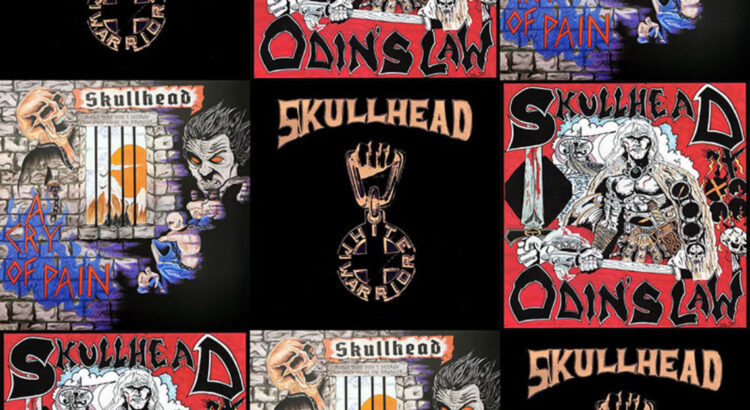British band Skullhead, led by their frontman Kev Turner, have carved out an undisputed and notable place in the world of skinhead rock and RAC.
Known for their provocative music and controversial lyrics, Skullhead provides an interesting case study, particularly through the albums ‘White Warrior’ (1987), ‘Odin’s Law’ (1989) and ‘A Cry of Pain’ (1991). A special focus is placed on the song ‘Blame the Bosses, not the Blacks’, which is in many ways uncharacteristic of a right-wing skinhead band.
The origins of Skullhead
Formed in Newcastle in the early 1980s, Skullhead contributed significantly to the development of the Oi! and skinhead scene. The band was always surrounded by political controversy, mainly due to their links with right-wing groups. Their frontman, Kev Turner, was often criticised for his explicit and polarising lyrics. However, regardless of political views, their musical development and especially their three albums deserve a closer look.
‘White Warrior’ (1987)
The debut album ‘White Warrior’ by the British skinhead band Skullhead, released in 1987, marked an important milestone in the group’s development. Musically, the record combines aggressive guitar riffs with catchy melodies and the hoarse yet powerful vocals of frontman Kev Turner.

On ‘White Warrior’, Skullhead managed to combine the hard and uncompromising attitude of skinhead rock with melodic and rousing song structures. The guitar work is characterised by a raw, punky energy without drifting too far into the extreme. Kev Turner’s distinctive voice lends the patriotic and historical lyrics a certain urgency and impact. At the same time, there are several choruses and melodies on the album that have a certain catchy tune potential.
Key Tracks:
- “White Warrior”: The title track is characterised by its fast pace and energetic instrumentation. The lyrics thematise identitarian and nationalistic ideas.
Whilst the album has been discussed in different ways in the music scene due to its political messages, it cannot be denied that musically it has a firm place in the skinhead rock genre.
‘Odin’s Law’ (1989)
Two years after their debut ‘White Warrior’, the British band Skullhead returned in 1989 with the follow-up album ‘Odin’s Law’. The record shows a clear musical maturation of the group and an improvement in production quality.
While ‘White Warrior’ still had a raw punk charm, the songs on ‘Odin’s Law’ sound more sophisticated and well-thought-out in their structures. The guitar riffs are more precise and the melodies are more memorable. Overall, the sound is punchier and more powerful than on its predecessor. The production gives Skullhead a grittier and more modern right-wing rock sound.
Key tracks:
- “Odin’s Law”: the title track shows a depth in the lyrics that was not so present before. The references to Norse mythology give the album a mystical flavour.
- “The Awakening”: Another important track that stands out with its epic structure and intense atmosphere.
- ‘Odin’s Law’ stands out for its thematic coherence and lyrical depth, making it one of the band’s most important works. ‘Odin’s Law’ cemented Skullhead’s status as one of the leading RAC acts in the UK. The album is considered an important milestone and influence for many later bands in the genre. Its ideological fervour and musical quality made it a cult album in the skinhead scene.
‘A Cry of Pain’ (1991)
With ‘A Cry of Pain’, the British RAC band Skullhead released their third and final studio album for Rock-O-Rama Records in 1991. The record shows a further maturation of the group, both musically and thematically.
Musically, ‘A Cry of Pain’ presents itself as Skullhead’s most varied and multi-layered album. Although the hard core of Oi! punk and right-wing rock remains, catchy melodies and rockier influences expand the sound. The production sounds clearer and more powerful than before. Frontman Kev Turner’s vocals seem more mature and multi-layered. Overall, a clear increase in quality can be heard in the songwriting and instrumentation.
Key Tracks:
- “A Cry of Pain”: The title track is an intense, emotional journey that addresses personal and social pain.
- “Fighting for Victory”: The lyrics describe in detail the “long and bloody battle for Tobruk” in North Africa in 1941/42, in which heavy losses were suffered on both sides. Among other things, Skullhead sings about the bravery of the German soldiers.
- “A Cry of Pain” marked Skullhead’s artistic peak. The band was able to increase their musical quality once again and express their views bluntly. The album is considered influential for the further development of British RAC due to its constantly differentiated viewpoint. With their three studio albums, Skullhead left behind a musical legacy that should not be underestimated.
Conclusion
Skullhead and their frontman Kev Turner remain an undeniable force in the skinhead and RAC scene. Their albums ‘White Warrior’, ‘Odin’s Law’ and ‘A Cry of Pain’ show a remarkable evolution in their music and subject matter, despite (or perhaps because of) their political leanings. The song ‘Blame the Bosses, not the Blacks’ (not included on the albums) offers an interesting change of perspective and demonstrates that even the most controversial artists can convey more complex messages. The message is anti-establishment and emphasises that the real culprits are not ethnic minorities but the economic and political elites.
As such, Skullhead remains an important band that has significantly influenced the RAC genre. Their music offers a rich palette of themes and emotions worthy of deeper consideration. In conclusion, Skullhead described themselves as a ‘third position’ band, writing mainly lyrics about British pride, Norse gods and anti-capitalism.
Links
Disclaimer:
We do not endorse the content of this video! The link to the video platform YouTube is for documentary purposes only.
